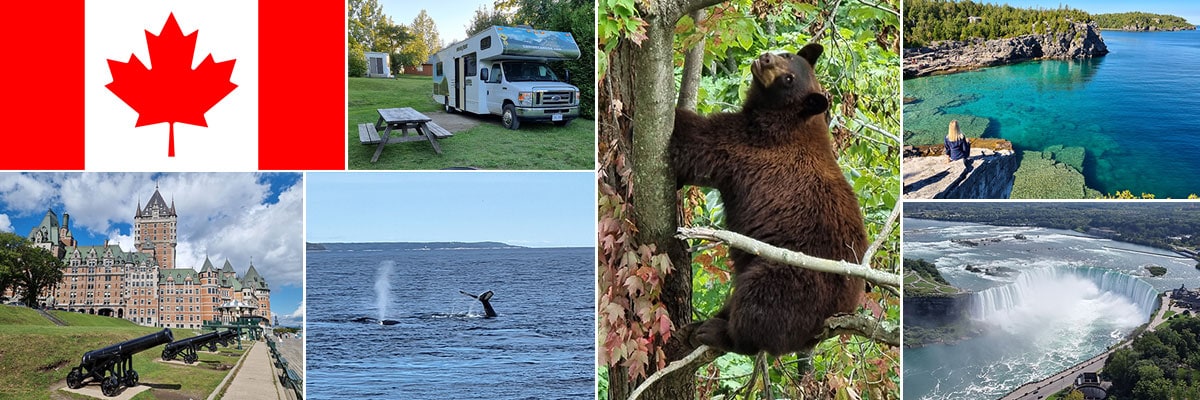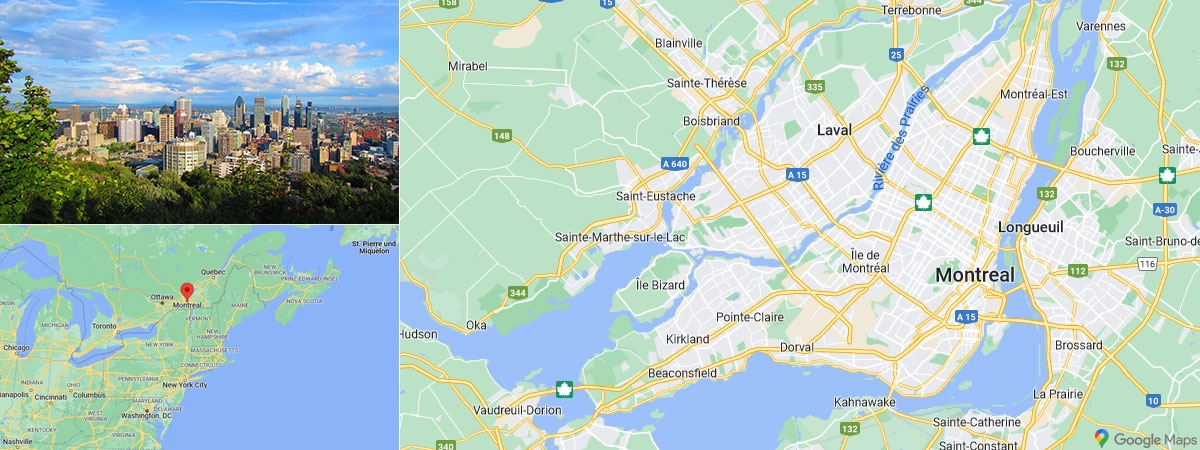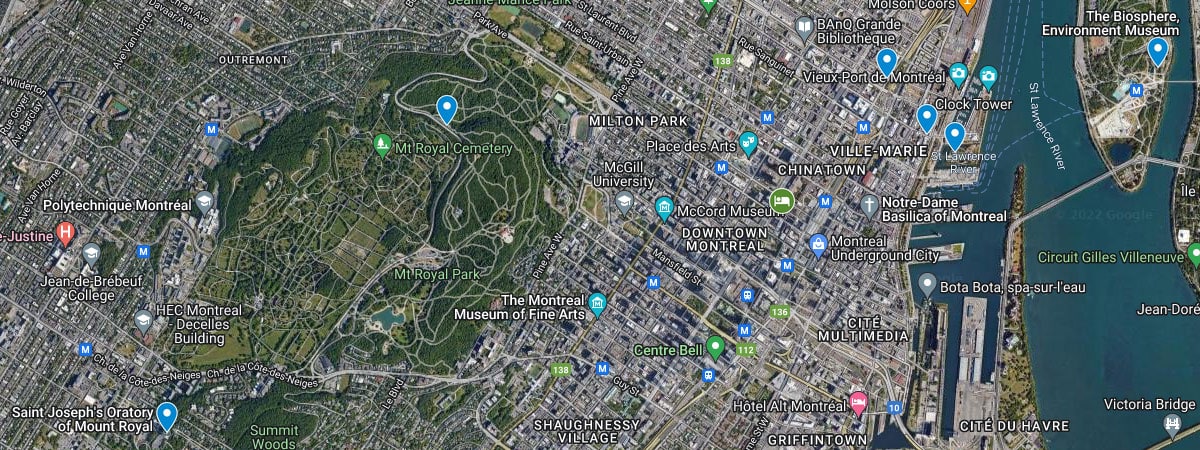The city of Montreal was the first and last stop of our round trip through the east of Canada. And even if we had never really had the city on our “to-do list” before, we were really excited. We definitely liked Montreal best of the Canadian cities compared to Toronto, Ottawa or Vancouver, similar to Québec City. There is a lot to see in the city on the St. Lawrence River and it is wonderful to explore the city on your own.

Table of contents
Interesting facts about Montreal
The city of Montreal in the province of Québec has around 1.7 million inhabitants, making it the second largest city in Canada after Toronto. More than 4 million people live in the metropolitan area. The French-speaking city (French is the official language and the main language) is located on an island at the confluence of the Ottawa River and the St. Lawrence River. The cityscape is dominated by Mont Royal, a 233 meter high volcanic mountain from which the city’s name is derived. The winters are usually long and cold. The average is down to -15°C, during snowy periods of frost even below -30°C. The summer is often short, hot and humid and mostly sunny with up to 27°C.
The most famous sights include the Old Town (Vieux-Montréal), the Roman Catholic Basilica of Notre-Dame de Montréal, the Saint-Josephs-Oratorium, the Mont Royal, the Marché Bonsecours, the Biosphère Montreal, the Botanical Garden, the Musée des Beaux-Arts, the waterfront and the Olympic Stadium.
– Montreal is often called one of the most beautiful cities in North America.
– Montreal was incorporated on May 17, 1642 and received city rights in 1832.
– The city’s name derives from Mont Royal (French: “royal mountain”).
– Most of the urban area is located on the Île de Montréal, an island 50 kilometers long and up to 16 kilometers wide.
– Montreal is the second largest city in the world after Paris where French is spoken as a first language.
– The city has 49 National Historic Sites, more than any other city in Canada.
– Completed in 1859, the Pont Victoria is a rail and road bridge across the Saint Lawrence River and was considered the longest bridge in the world when it opened.
– Montreal’s highest point is Mont Royal at around 228 meters.
– Montreal is a major port city as well as a financial, business and transportation center.
– Temperatures can drop as low as -40°C in winter.
Our Hotel in Downtown Montreal
For our last two nights in Canada, we chose the AC Hotel by Marriott Montreal Downtown, which is very centrally located in downtown and therefore perfect for exploring the city. The old town is about a 10-minute walk away, and the nearest metro station, Place-d’Armes, is about 5 minutes away. Diagonally opposite there are several shops, restaurants and a large IGA supermarket in Complexe Desjardins.
Our room was very clean & modern and we felt really comfortable. In total we paid CAD 342 (without breakfast) for our room for 2 nights via Booking.com, which is about EUR 250. We can really recommend the hotel.
The most famous sights & most beautiful photo spots in Montreal
The sights in Montreal are sometimes quite far apart, so that you need several days to explore the most important attractions. But the city has a very well developed public transport system operated by the STM. In addition to the metro system, there are around 140 bus routes and two commuter trains. It’s pretty easy to get from A to B, and it’s a great way to explore Montreal on your own.
The Passeport MTL lets you experience 5 Montreal attractions for one cheaper price. You can choose 3 attractions from the “Pink Collection” (e.g. river cruise, Ferris wheel, kayak tour, quadricycle, pedal boat, bicycle tour) and 2 attractions from the “Blue Collection” (e.g. Château Dufresne, Château Ramezay, Écomusée du Fier Monde , SOS Labyrinths, McCord Museum or MTL Zipline). You also get discounted entry to other attractions. The MTL Pass currently costs 95 CAD, i.e. around 70 EUR. We had this pass for our Montreal stay and used it for the botanical gardens, a ride on the Ferris wheel, the zipline and a river cruise.
Old Town (Vieux Montreal)
We started our tour in the old town of Montreal. The history of Vieux-Montréal – Old Montréal – dates back to the 17th century when the French landed on the banks of the St. Lawrence River and established a settlement there. Today, the historic district is one of the city’s best-known attractions. Here you will find centuries-old cobblestones, nostalgic street lamps, rattling horse-drawn carriages, beautiful boutiques, galleries, restaurants, cafes and souvenir shops. The government of the province of Quebec protected the old town as an “Arrondissement Historique” (historic district), which also includes the Old Port of Montreal.
Our first photo stop was the old Law Courts on Rue Notre-Dame St. East. The gray stone building with a monumental portico was built between 1851-1857 and enlarged in 1890. Directly opposite is the 1922 Ernest Cormier Building, another Grade I listed courthouse in the Old Town. Passing the Place Vauquelin one arrives at the Hôtel de Ville, the City Hall of Montreal. Unfortunately, this was completely scaffolded during our visit due to restoration measures.
If you still want to explore a little history of the city of Montreal, you can make a short detour to the Parc du Champ-de-Mars, which is located directly behind the city hall. Here you can find part of the old stone city wall from the 18th century, which was originally about 3.5 km long and up to 6.4 m high. 250 meters of this were uncovered in the Park Champ-de-Mars and the contours of the fortification were also made visible in the floor covering on the Place Jacques-Cartier.
Directly opposite the Hôtel de Ville is the Château de Ramezay. The building was built in 1705 as a governor’s residence and is one of the oldest surviving buildings in the city. A French-style garden extends to the rear of the château. Unfortunately, we were there 5 minutes before closing time, so we couldn’t visit the château from the inside.
Next, we walked across the Place Jacques Cartier to the Rue Saint-Paul, where the old market hall and the pilgrimage chapel of Notre-Dame-de-Bon-Secours are located. The Marché Bonsecours , inaugurated in 1847, is considered one of the ten most beautiful monuments in Canada, is a listed building and has been a National Historic Site since 1984. The 163-metre neo-classical-style building made of gray limestone temporarily served as the town hall and parliament building and is now home to various art, design and craft boutiques.
On our tour of the old town we saw many other beautiful buildings, such as the magnificent houses in Place Jaques Cartier or the former Customs House, an elegant two-story building from the early nineteenth century. Since 1992, the Customs House has been part of Pointe-à-Callière, the Montréal Museum of Archeology and History, and is connected to the other buildings of the museum complex by an underground passage. Otherwise you will find many small shops, cafes, bars and restaurants in the old town.
Place d’Armes & Basilica Notre-Dame de Montréal
The Place d’Armes and the Basilica Notre-Dame de Montréal are also part of the old town. The Place d’Armes, at the center of which the Maisonneuve monument has stood since 1895, is the second oldest public square in the city. The buildings surrounding the square represent different epochs of architectural development. The Notre-Dame de Montréal basilica, built between 1824 and 1829, is on the south-east side. Right next to it is the 1684-1687 built Sulpician Seminary (Vieux Séminaire de Saint-Sulpice), today the oldest surviving building in the city. Across the square, facing the basilica, is the headquarters of the Bank of Montreal, dating from 1859.
Chinatown district
The Chinatown district is also one of the historic places in the city today. Chinatown is a square block with 4 large dummy gates placed at each corner. The bustling part of town emerged in the early 1890s. With the opening of several Chinese shops and laundries on the street “De le Gauchetière”, a separate district slowly began to develop.
Olympic Park
On our way to the Botanical Gardens we passed the grounds of the Olympic Park (Parc Olympique), which was built for the 1976 Summer Olympics in Montreal. A distinctive feature of the stadium is the inclined tower, which at 175 meters is the tallest inclined tower in the world.
Botanical Garden
One of our highlights in Montreal was visiting the Botanical Gardens. This oasis in the city really is a great destination and is rightly considered one of the largest and most beautiful gardens in the world. From the nearest subway station, Pie-IX, it takes only about 5 minutes to walk to the entrance of the Jardin Botanique de Montréal. The garden is very large and we spent several hours here because there is something to discover around every corner.
The botanical garden was founded by Brother Marie-Victorin in 1931 and today includes a rich collection of 22,000 different plant species, 10 exhibition greenhouses and around 30 themed gardens. The Great Chinese Garden displays traditional Chinese garden art and is the largest outside of China. The Japanese Garden houses bonsai trees that are up to 150 years old and the First Nations Garden shows native plants such as maple, birch and pine.
The 75 hectare Jardin Botanique has been designated a National Historic Site of Canada as it is considered one of the most important botanical gardens in the world for the breadth of its collections and facilities.
Biosphere on Saint Helen Island
Another great photo spot is on the island “Saint Helen Island” – the Biosphère Montreal. This spherical structure is a water and environmental museum dedicated to the ecosystems of the Great Lakes and the St. Lawrence River. The Biosphère was opened on the occasion of the “Expo 67” world exhibition in 1967. The diameter of the sphere is 76 meters and the height is 62 meters. The sphere consists of a steel structure covered with acrylic honeycomb.
Other attractions on Saint Helen Island include Fort de l’Île Sainte-Hélène, built in 1818, and La Ronde amusement park, operated by Six Flags.
The Old Port
Montreal’s Old Port is one of Montreal´s most popular landmarks and a popular destination for tourists and locals alike, with over 6 million visitors annually. The harbor promenade stretches two kilometers along the St. Lawrence River and was used as a trading post by French fur traders as early as 1611. In the early 1990s, the Old Harbor was extensively redesigned and is now the scene of a variety of cultural, water sports and other leisure activities. We really liked the flair here, there was something going on everywhere and there was a lot to discover.
It is also home to several popular attractions, including the Ferris wheel (La Grande Roue de Montréal), an ice skating rink (Old Port Skating Rink), the MTL Zipline, the SOS Labyrinthe, the Montréal Science Center, Cirque du Soleil, a municipal beach with fine sand and the new “Port of Montreal Tower”, an observation tower directly at the cruise terminal at Alexandra Pier.
One of the most famous buildings in the Old Port is the clock tower, built between 1919 and 1922 to mark the entrance to the port and to commemorate the sailors who died at sea during the First World War. The Clock Tower has been declared a Canadian Cultural Monument.
Ferris wheel
Shortly before sunset we did another lap on the 60-meter-high Ferris wheel, from whose gondolas you have a wonderful view of Montreal, the Saint Lawrence River and the island of Saint Helena. The Ferris wheel is open daily from 10 a.m. to 11 p.m. A ride takes about 20 minutes and costs CAD 28.74 per person, which is about EUR 21.
More Attractions
Of course there are many other sights in Montreal, which unfortunately we could not visit all due to the time.
We would have loved to have taken another trip up Mont Royal, one of the city’s largest green spaces and therefore a popular outdoor recreation spot. Like New York’s Central Park, it was designed by Frederick Law Olmstad and offers a wonderful view of the city. At the southwest entrance is also the Basilica of Saint Joseph’s Oratory. Other highlights of the city include the Musée des beaux-arts de Montréal, the Museum of Archeology and History, the Jean-Talon Market, the Observatoire Place Ville Marie, the Jean-Talon Market and the extraordinary residential complex Habitat 67.
A sightseeing cruise on the St. Lawrence River
Thanks to the Passeport MTL mentioned above, we also had the opportunity to see the city of Montreal from the water. For this we did a 1.5 hour river cruise with Croisières AML. From the Old Port we drove downstream under the Jacques Cartier Bridge and learned a lot about the city from the audio guide.
A video from Montreal
You can find some really nice impressions of the most famous sights in Montreal in this video on YouTube.
The Starbucks cup from Montreal
We are collecting the Starbucks Mugs from the cities and islands we visit on our travels. Unfortunately, not every city that has a Starbucks store with an own mug. But if the city has an own mug we like to collect them as a souvenir. We only collect city mugs from the "Global Icon Series", which was released in 2008. You can see our complete collection here: Starbucks - Our collection of Mugs from the Global Icon SeriesOf course, the city of Montreal has several Starbucks stores and also its own motif mug. Since this cup from the Global Icon series has not been available for purchase in Starbucks stores for a long time, it is now also relatively expensive as a collector’s item.
A map with all attractions in Montreal
On the following map on Google MyMaps we have drawn all the important sights and photo spots in Montreal.
All travel reports from our camper round trip through Canada
Vacation with the camper or motor home in Canada - for many probably quite normal, but for us it was actually the first time. We have never been on the road with a camper, but always wanted to try it. In total, we drove almost 3,300 kilometers with our camper and explored beautiful regions and cities in eastern Canada. » Our Holiday in Canada 2021 - Flight, Entry & Itinerary
» Our Holiday in Canada 2021 - Flight, Entry & Itinerary» Camping in Canada - Our Questions, Experiences & Tips
» La Mauricie National Park - A hike on the Les Cascades Trail
» Québec City - Things to do, Sights & Photo Spots
» Canyon Sainte-Anne - Waterfalls, Cascades & Suspension Bridges
» Tadoussac - Whale watching on the Saint Lawrence River
» Parc Omega - Drive-Through Safari in Quebec
» Ottawa - The capital city of Canada
» Algonquin Provincial Park - Lakes, forests and magnificent viewpoints
» Bruce Peninsula National Park - Dreamlike bays at Lake Huron
» Niagara Falls - The largest waterfalls in North America
» Toronto - Things to do, Sights & Photo Spots
» Thousand-Islands National Park - 1.864 Islands in the Saint Lawrence River
» Montreal - Things to do, Sights & Photo Spots



